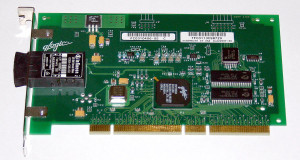Fibre Channel overview
Fibre Channel (FC) is a high-speed network technology used to connect computer data storage in an enterprise environment. FC works by encapsulating SCSI commands and transmitting them between FC nodes. Each ESXi host is equipped with at least two Fibre Channel host bus adapters (HBAs), devices that connect the ESXi host to the FC network and support a very high throughput of up to 16 Gbps. Here is what a host bus adapter looks like (source: Wikipedia):
There are three major FC topologies:
- Point-to-point (FC-P2P) – two devices connected directly to each other. Rarely used today.
- Arbitrated loop (FC-AL) – all devices are in a loop or ring. Rarely used today.
- Switched fabric (FC-SW) – all devices are connected to FC switches, devices similar to Ethernet switches, but compatible with the Fibre Channel (FC) protocol. Most array designs today use this topology.
FC storage can be used in a vSphere environment to hold VMFS datastores. VMFS datastores store virtual machine files, templates, and ISO images and can be shared across multiple ESXi hosts, enabling advanced vSphere features such as vMotion, HA, and DRS.
Although FC was initially developed to use only optical (fiber) cabling, copper cables are also supported.




